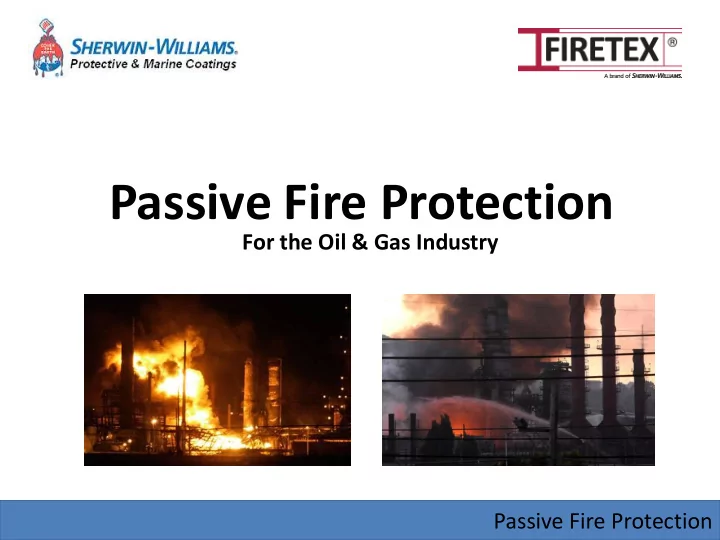

Passive Fire Protection For the Oil & Gas Industry Passive Fire Protection
What is purpose of fireproofing? To Save Lives To Preserve Assets To Prevent Escalation Passive Fire Protection
Passive Fire Protection
Passive Fire Protection
Flares-Boilers-Fired heaters-Static Electricity-Electrical Motors-Vehicle traffic-Hot Work-Hot Surfaces-Lighting- Overhead High Voltage Lines-Mechanical Sparks, Friction, Impact, Vibration-Chemical Reactions
Passive Fire Protection (PFP) remains unreactive until exposed to heat/fire. PFP materials limits heat absorption by steel structures when exposed to fire for a defined and tested period of time. Typical PFP used in hydrocarbon processing: Steel Strength Reduction with Temperature (2% strain) Data approximation from Euro Code 4 graph • Dense Concrete 1.2 • Lightweight Cementitious 1 • Intumescent Coatings Reduction Factor 0.8 0.6 Strength reduction 0.4 0.2 0 0 100 200 300 400 500 600 700 800 900 1000 1100 1200 Temperature Degree C Passive Fire Protection
1200 2192 ° F 1000 1832 ° F 800 1472 ° F TEMP(°C) 600 1112 ° F CELLULOSIC CURVE 400 752 ° F HYDROCARBON CURVE 392 ° F 200 UL 1709 CURVE 0 ° F 0 0 20 40 60 80 100 120 140 TIME(MINS) Passive Fire Protection
Dense Concrete is made with Portland cement with gravel and weights 140 to 150 lbs/ft³. Concrete absorbs heat through an endothermic heat reaction. Passive Fire Protection
Lightweight Concrete (LWC) uses very light aggregate, such as vermiculite or Perlite instead of gravel. Dry densities range from 25 to 80 lbs/ft³. LWC is usually sprayed on , but may be trowelled or formed in-place using reinforcing mesh/lathe. Passive Fire Protection
Plant Mechanical Damage Passive Fire Protection
Corrosion Under LWC Fireproofing Concealed Heavy Corrosion Passive Fire Protection
Cementitious Fireproofing has no chemical resistance and will degrade in acidic exposure! Passive Fire Protection
Intumescent mastics expand to several times their volume when exposed to heat, and form a protective insulating char barrier that faces the fire. Passive Fire Protection
Plural Component Spray Units Passive Fire Protection
Passive Fire Protection
Passive Fire Protection
The magnitude of fires are primarily influenced by: • Fuel type • Volume of fuel • Pressure of release Pool Fire Jet Fire Approx.Temp 1100 1200 . ( o C) (2012ºF) (2192ºF) 150 – 205 300 – 320 Typical Heat (47,550 to 65,000 (~100,000 Flux Btu ft -2 hr -1 Btu ft -2 hr -1 ) (kW m -2 ) Erosion Limited Severe Passive Fire Protection
Passive Fire Protection
Passive Fire Protection
Fire ratings are primarily determined by: 1. Time Required to block flows and backflows of fuel that may be released. 2. Response time and capability of fire brigades 3. The availability and flow capacity of an uninterrupted water supply. 4. Time required to engage fixed water spray systems 5. Time required for drainage system to remove spill 6. Evacuation time required Passive Fire Protection
UL 1709 test W10 X 49 Column UL 1709 “Rapid Rise Fire Tests of Protection Materials for Structural Steel” Passive Fire Protection
UL 1709 Performance Criteria 6.1 “The transmission of heat through the protection material during the period of fire exposure for which classification is desired shall not raise the average temperature at any of the four levels of the steel 1000 ° F (538 ° C) column above and no thermocouple shall indicate a temperature greater than 1200 ° F(649 ° C). ” Passive Fire Protection
UL 1709 Limitations: • One Test Structure Tested (W10 X 49 H-Section Column) • One Thickness – Smaller mass structural members are under protected – Larger mass structural members use more material than required resulting in unnecessary cost and weight • Failure Temperature 1000 ° F (50% of steel strength) • Limited to pool fire…no jet fire calculation data • Limited to structural steel testing Passive Fire Protection
Passive Fire Protection
Certificates are issued for the following structure types in various Hp/A, W/D, or A/P and critical fail temperatures: 1. I Sections 2. Structural Hollow Sections 3. Steel Decks (Plate Steel Floors) 4. Steel Bulkheads (Plate Steel Walls) Passive Fire Protection
Steel Dimensions Affect Heat Absorption Passive Fire Protection
In order for fireproofing systems to meet the requirements of the Risk Assessment, the following must be carefully considered by engineering: 1. Pool and/or Jet Fire 2. Critical Temperature 3. Steel Member: plate, structural, HSS, etc. 4. Steel Dimensions Passive Fire Protection
Fire Protection Of Assets Requires Collaboration! Risk Assessment Personnel Managing Fire Risks Everyone has an important role in saving lives, preserving assets, and preventing escalation! Passive Fire Protection
Passive Fire Protection
Recommend
More recommend